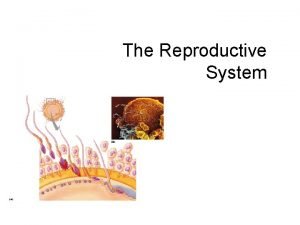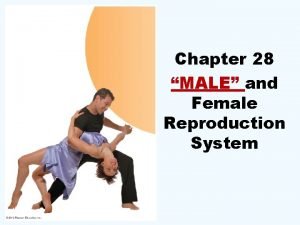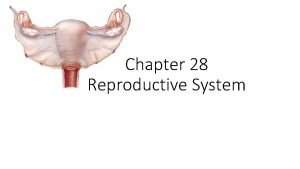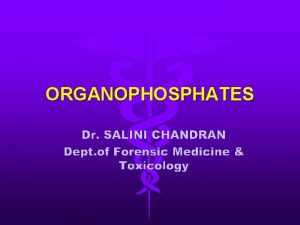ORGANOPHOSPHATES AND MALE REPRODUCTIVE HEALTH Melgarejo M Mendiola












- Slides: 12

ORGANOPHOSPHATES AND MALE REPRODUCTIVE HEALTH Melgarejo M, Mendiola J, Koch H, Moñino-García M, Noguera. Velasco J, Torres-Cantero A.

BACKGROUND Organophosphates: • Most widely used pesticide (Agriculture, home, garden, veterinary practice)² • Damages acetylcholinesterase, affects nerve signaling in body • All organophosphates cause similar symptoms in humans who have same exposure Exposure: May be present in soil, surface waters, and surface of plants Rapidly broken down and do not build up in the environment Can be exposed via workplace contact, ingestion, touching contaminated soil or groundwater Eating contaminated food is most common source of exposure

ORGANOPHOSPHATES AND REPRODUCTIVE HEALTH When metabolized, six dialkylphosphates metabolites can be made: Dimethylphosphate (DMP) Dimethylthiophophate (DMTP) Dimethyldithiophosphate (DMDTP) Diethylphosphate (DEP) Diethylthiophosphate (DETP) Diethyldithiophosphate (DEDTP) Aim of study: correlate urinary concentrations of six dialkylphosphates (DAPs) and reproductive parameters in men. Volume, concentration, total sperm count, motility and morphology, and tested for hormones present (follicle stimulating hormone, luteinizing hormone, testosterone, prolactin and estradiol) Animal studies have shown that organophosphates can impair serum reproductive hormone concentrations and semen parameters

MATERIALS AND METHODS Observational analytical cross-section study from December 2012 to July 2013. Requirements: ØMust be able to speak and write Polled men attending infertility services at Virgen de la Arrixaca University Hospital Spanish in Murica Region of Spain. ØNo vasectomy, STI/STDs, contagious disease or previous oncology treatment Men were unaware of fertility status when Ø 25 -38 years old they went to the clinic.

MATERIALS AND METHODS CONT. Demographics of men tested: ØMean BMI: 28. 2 (Overweight) Ø 4% reported being born with Ø 220 invited for the study, 116 one or both testicles undescended. were used for statistical evidence (53%) Ø 29% reported having varicocele ØAll Caucasian ØAverage age: 35. 1 Ø 22% smoke

MATERIALS AND METHODS CONT. Day of Clinic: ØAndrological exam ØProvide a semen and urine sample ØBlood draw ØEpidemiological questionnaire on lifestyle and general health All but the semen sample were tested on site in Spain. The semen sample was tested in a lab in Bochum, Germany.

RESULTS All men showed at least one urinary organophosphate (OP) metabolite. ØSignificant inverse correlation between urinary DMP and percentage of motile sperm. ØSignificant positive association between DEDTP concentration and lutenizing hormone and follicle stimulating hormone. ØSignificant negative association between DEDTP concentration and testosterone to lutenizing hormone ratio. ØSignificant inverse association between DMTP, DMDP, and DEP and motile sperm count. ØSignificant inverse association between urinary DMP and DMDTP concentration and total motility count. ØSignificant inverse association between urinary concentrations of DMP, DMDTP, and DMDTP and sum of all DAP and sperm concentrations and total sperm count.

DISCUSSION Current study shows exposure to OP pesticides measured via urinary DAP metabolite concentrations is negatively associated with sperm concentration, count, and motility in males seeking infertility treatments. Although the increase in OP use is due to low persistence in environment, OP’s are not free of toxic effects. The main risk is over accumulation of acetylcholine (neurotransmitter) in the body which gives rise to know neurotoxic effects. As for damage to the male’s reproductive system, no consensus is available yet. It could be due to different developments in the spermatogenesis cycle.

LIMITS Small case size yields a difficulty in pointing specific exposure sources. Not able to pin point specific times of exposure in relation to the spermatogenesis cycle, a typical 70 day cycle.

SIGNIFICANCE TO PUBLIC HEALTH Increase in pesticide usage due to lack of environmental issues can cause problems to the general public. Important in furthering research concerning different aspects to increased organophosphate usage and other pesticide usage.

ACTION TO BE TAKEN More studies need to be conducted to test if organophosphates can alter male’s reproductive health and hormonal health. If one is trying to conceive a child, taking precautions as to organic or conventionally grown produce and goods may increase the likelihood of conception.

REFERENCES 1. Melgarejo M, Mendiola J, Koch H, Moñino-García M, Noguera-Velasco J, Torres. Cantero A. Associations between urinary organophosphate pesticide metabolite levels and reproductive parameters in men from an infertility clinic. Environmental Research. February 1, 2015. Accessed October 11, 2015. 2. Frequently Asked Questions About Organophosphates. Center for Disease Control and Prevention website. http: //www. cdc. gov/nceh/clusters/fallon/organophosfaq. htm. Accessed October 11, 2015. 3. Variocele. Mayo Clinic website. http: //www. mayoclinic. org/diseasesconditions/varicocele/basics/definition/con-20024164. Accessed October 11, 2015.
 Carolyn mendiola
Carolyn mendiola Reproductive hygiene
Reproductive hygiene Male and female reproductive system
Male and female reproductive system Male fallopian tube
Male fallopian tube Differences between male and female reproductive organ
Differences between male and female reproductive organ Drawing of the male and female reproductive system
Drawing of the male and female reproductive system Hyena testicles
Hyena testicles Diagram of male and female reproductive system of fish
Diagram of male and female reproductive system of fish Male reproductive system from front
Male reproductive system from front Exercise 42 anatomy of the reproductive system
Exercise 42 anatomy of the reproductive system Male reproductive system lateral view
Male reproductive system lateral view Pearson
Pearson Figure 16-1 male reproductive system
Figure 16-1 male reproductive system























